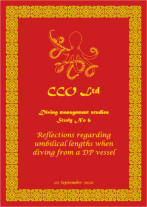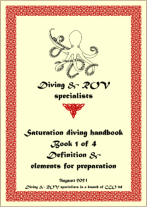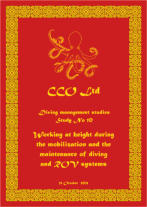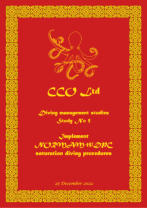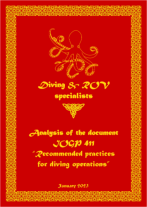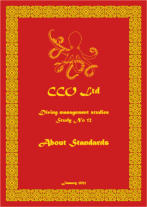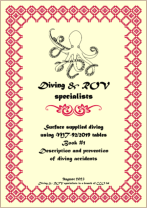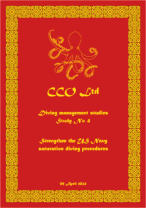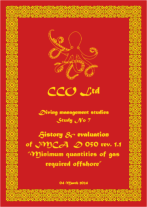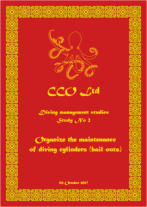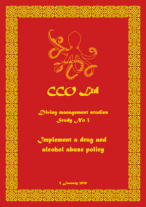Diving & ROV specialists




This website's purpose and terms of use are
delineated in the "About Us" section in the
navigation bar at the top of each page.
Click on this octopus icon to view its structure.

Publications CCO Ltd
and
Diving & ROV specialists

Scientific publications

Videos and animations

Procedures, historical diving,
and other technical documents
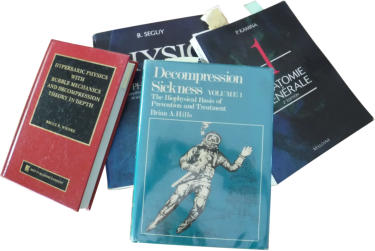
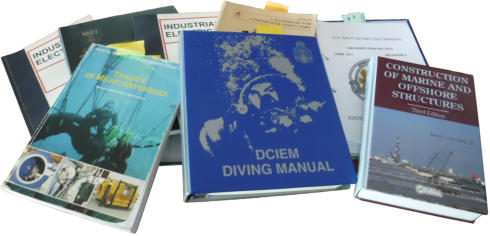

Equipment to take into consideration


Help us to make this website better
This website is the result of the combined efforts of scientists,
document writers, engineers, divers, and client representatives. It
stands as an independent platform committed to providing accurate
and honest information, free of any external influences from pressure
groups. However, maintaining this level of quality requires a significant
time investment. As such, any support towards improving this project
would be greatly appreciated.
The following hyperlink permits contributions to be made via
"Librapay.com", a platform for donation crowd-funding.
As our principal office is in Thailand, the currency of reference for
donations is the Thai Baht. It should be noted that 1 USD equals
approximately 36-40 THB. .

Click on the
octopus to return to
the top of the page

Food for thought

Cultural activities
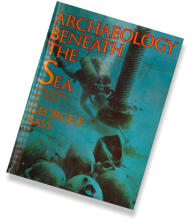

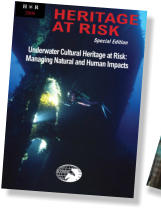

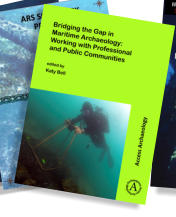
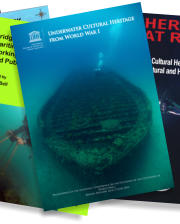
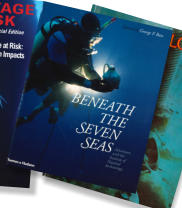
You can also help us by contributing articles or information.
You do not need to be a recognized scientist or engineer (although their
contributions are always welcome) and provide papers of the level of
those in the "Documents" section: Small, well-balanced posts in which
you tell us your thoughts on particular topics can be accepted and
published in the "Food for Thought" section, provided they are based on
proven facts and in accordance with our terms of use, displayed in the
"About Us" section (see in the navigation bar).
If you do not feel like a writer but have a recognized technical level, you
can join the team as an advisor and helper.
Best regards.
Christian Cadieux - Website manager.

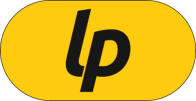
Moreover, it is possible to initiate transfers to a designated account via
SWIFT (with code SICOTHBK) or through traditional bank transfers.
For further information on the bank account particulars, kindly refer to
the "About us" section.
The documents categorized under the "Diving and ROV Specialists" and
"CCO Ltd" headings are in line with this website's mission to act
independently of external bodies by providing diving and ROV crews
with reliable information that we consider appropriate to the subject
matter. These resources are based on scientific and technical
documentation held within our database and nationally and globally
recognized standards and guidelines selected for their relevance.
Click on the button below the image to view the available documents
and their descriptions.


This section relates to underwater archaeology documents, museums
and all activities that promote the history of diving and navigation. Our
database contains about 183 papers by real archaeologists, UNESCO
reports and regulations concerning these activities, which should be in
accordance with the "United Nations Convention on the Parts of the Sea
Under the Authority of States". There is also a list of downloadable
museums.
While archaeologists have often used the services of recreational
divers for years, the exploration of deep wreck sites inaccessible to
such divers may require them to use the services of professional
diving and ROV teams, applying the procedures in force in the
offshore industry.
Please note that 13 new documents have been added to our database.
Click on the button below to view the list.

Videos and animations are available through the main 'Documents'
section; these are presentations of equipment, systems, and working
practices provided by manufacturers, people at work, and various
organizations, that can be used to illustrate courses, toolbox talks, and
conferences.
Based on the above, the database is regularly updated with documents
related to the articles published in the "Food for Thought" and
"Equipment to Consider" sections.
Nine new animations have been added to the database. You can see the
list by clicking on the button below. You can also click on the images
above to open the pages where they are described and can be opened.

The purpose of this section is to provide small articles describing new
equipment that may be useful in organizing underwater operations. Its
other function is to highlight dangerous equipment, such as counterfeit
or poorly designed or manufactured systems, which may expose
users to hazardous conditions.
Please note that our previous articles remain in our database and can
be consulted at any time. Click on the button below to access them.

News
Also, recent announcements from various professional and safety
organizations, and lists of scientific and technical paid documents can
be consulted on a specific page by clicking the button below.

Please note that the hyperlinks to the guidelines and information
notes indexed in this section are provided for informational purposes
only. "Diving and ROV Specialists.com" assumes no responsibility for
the creation of any of these documents.
As stated in our "About Us" section, we operate independently and
have no plans to seek organizational membership. Our mission is to
furnish diving and ROV teams with reliable information written by us
or others, including materials published by professional organizations
that we consider integral to our responsibilities.
Nevertheless, as elucidated in Diving Management Studies CCO Ltd
#7 and #11's conclusion, every guideline put forth by an
organization must be scrutinized by qualified individuals who
determine its feasibility for their respective companies' utilization.
In other words, it is your prerogative to deem each document on this
page suitable or unsuitable for all aspects of your diving and ROV
operations.

Logistics
•
Diving doctors & clinics
•
Medical equipment
•
Diving equipment manufacturers & suppliers
•
Underwater tools and their surface support equipment
•
ROV and AUV manufacturers
•
Underwater navigation and visualization systems
•
Logistic supporting services
•
Ship chartering companies
•
Shipyards
•
Training establishments & Recruitment agencies
•
Banks, insurances, and medical assistance
The Logistics section includes the following sub-sections, which
provide links to manufacturers and service providers. As with all our
other sections, we take pride in checking the hyperlinks every time we
update the site. However, it is important to note that websites can
malfunction for various reasons, even if they have worked seamlessly
during the overhaul.
The "Food for Thought" section disseminates concise articles on
various topics, providing readers with thought-provoking material that
facilitates the analysis of potential new markets and events that may
affect our respective professions now or in the future.
By adopting a non-monocultural approach to the development of our
professions, we can broaden our horizons and remain adaptable to
changing circumstances.
Please note that previous publications in this section remain in our
database and can be consulted at any time.
Click the button provided below to access the list and choose your
preferred article.



Studies of ROV and AUV Concepts


For those who prefer the convenience of sending money with just a
few clicks, “Skrill Money Transfer” is an international money transfer
service that offers more favorable rates than traditional banks.
To utilize this service, you must first register for a Skrill account by
downloading the app from Google Play or the App Store or visiting their
website at "https://skrill.com/en" and clicking the button "register."
Once registered, you can log in to your account and send money to
anyone registered on Skrill or make an international money transfer
by following step-by-step instructions.
As mentioned above, our bank account details are indicated in the
"About Us” section, which can be accessed via the navigation bar.
If the recipient's bank information is unavailable, funds can be sent
using their email address (for us, use: "management@diving-rov-
specialists.com"`). The transferred amount typically becomes
immediately available once it is completed.
More information is available by clicking the logo below.

The search engine above allows for finding
documents and addresses using keywords.
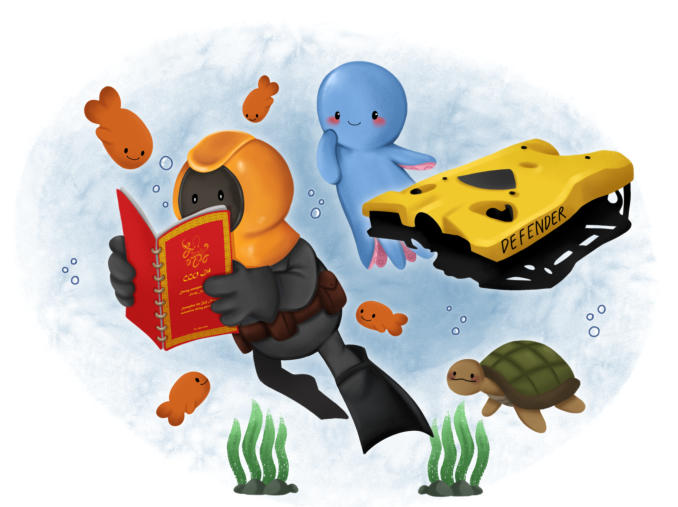

Edition of the 25th of April 2025
This section contains papers dealing with technologies applicable
to remotely operated and autonomous underwater vehicles. They
can be considered scientific studies dedicated to the above-
mentioned equipment.
56 documents have been added to our database, which contains
documents from the fifties to the present days.
Click on the button below to open the list of these new documents
Our database has been enriched with an additional 121 papers
covering various topics, such as:
•
Diving and ROV procedures.
•
Historical diving
•
First aid
•
International conventions and national laws.
•
Technical documents regarding vessels and diving systems
•
Non-destructive inspection techniques
•
Underwater mapping
•
Environmental studies
Kindly click on the provided link below to access the full list.


In addition to the documents mentioned above, 75 new papers
dealing with underwater construction techniques and procedures
have been added to the database.
Their list can be viewed by clicking the button below.
The Diving Management Study CCO Ltd. No. 8,
"Set a policy for electronic devices in
chambers" is based on reports from QinetiQ,
a multinational defense technology company
headquartered in Farnborough, United
Kingdom, and from the aviation industry,
which deals with the problems posed by
these devices on a daily basis and has
developed efficient methods for managing
them. Therefore, rather than strictly
The study CCO Ltd. No. 10 "Working at Height
during the Mobilization and Maintenance of
Diving and ROV Systems" is based on incident
reports from diving client representatives
and guidelines from the European and
similar international standards, which are
faithfully reproduced. The aim of this
document is to provide methods to reduce the
risks associated with these activities, which
are too often neglected by divers.
prohibiting the use of electronic devices, including cell phones, in the
chambers, this document proposes methods and tools to manage
them efficiently so that divers are not deprived of their use while at
the same time implementing strict control measures to ensure that
these devices do not cause additional harm.
Several papers are currently being written that require the review of
numerous documents and consultations with scientists working on the
topics discussed, who have their own schedules, extending the writing
process beyond the initially anticipated timeframe. In addition, these
papers are based on some scientific articles that have not yet been
published. Consequently, their publication depends on the publication of
these reference papers. Also note that many new documents have
been added to the website database, and it is planned to include them
in the written manuals later this year. In the meantime, the two "Diving
Management Studies CCO Ltd." below and others provide documented
and innovative guidance on the topics they discuss and should be read.

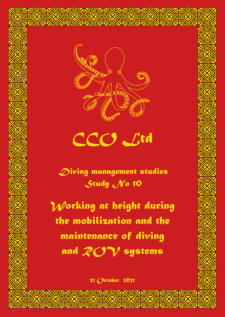
"NDTT – Probability of Decompression
Sickness" is a document written by Doctor
Risberg, intended to supplement the safety
information and instructions for
implementing the Norwegian Diving and
Treatment Tables (NDTT) that have been
systematically added to these tables since the
fourth edition. Its purpose is to provide
straightforward information on the
decompression sickness rates methods used
"N2 exchanges in hyperbaric environments:
toward a model based on physiological gas
transport (O2 and CO2)" by Michael Theron
Alexis Blasselle, Lisa Nedellec, Pascal Ballet,
Emmanuel Dugrenot, Bernard Gardette,
François Guerrero, Anne Henckes, and Jean-
Pierre Pennec explains a new model for inert
gas exchange showing the integration of
various physiological factors for improved
nitrogen saturation and desaturation models.
We continue to enrich our database with scientific documents actively.
Note that although most of these documents cover phenomena related
to diving, many of them also cover health problems associated with
the use of ROVs and various deck activities. Therefore, these papers
should be considered the basis on which guidelines and standards
should be built and should always be mentioned by the authors of
these procedures, guidelines, and standards.
to create and keep these tables current with the latest research.
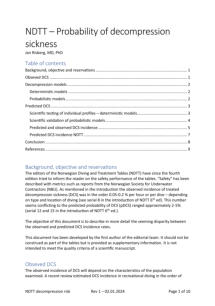
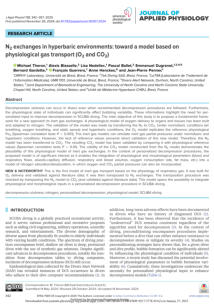
Autonomous Underwater Vehicles (AUV)
path-following performance and safety in
complex underwater environments is
crucial, this study proposes a conservative
offline model-based Q-learning (CMQL)
algorithm for this purpose. CMQL is
robust, uses data efficiently, and does not
require fine-tuning. It uses limited AUV
motion data for training, which enables
accurate long-term predictions.
As mentioned in the previous editions, we continue to work
diligently to expand our database with a wide variety of
documents related to bio-inspired underwater vehicles and
advances in the field of artificial intelligence.
Among the papers included in this edition, we highlight the study
titled "Model-Based Offline Reinforcement Learning for AUV Path-
Following Under Unknown Ocean Currents with Limited Data" by
Xinmao Li, Lingbo Geng, Kaizhou Liu, and Yifeng Zhao.
Considering that minimizing experimental data while ensuring
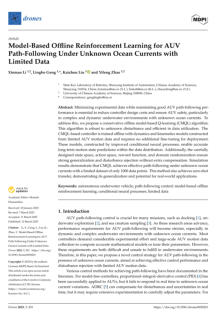
In previous editions, we have highlighted the increasing reliance on
Remotely Operated Vehicles (ROVs) and Autonomous Underwater
Vehicles (AUVs) for non-destructive testing (NDT) inspections and
mapping tasks and the integration of these advanced technologies into
these activities. In addition, we should also focus on the other new
techniques designed to meet the specific requirements of these NDT
and mapping applications, as outlined in the documents below:
“An overview of industrial image
segmentation using deep learning models”
by Guina Wang, Zhen Li, Guirong Weng, and
Yiyang Chen is a study that evaluate
learning segmentation algorithms. It
discusses various label frameworks and
compares methods on benchmark
datasets, addressing challenges and
opportunities for future research.
“Advancing inspection techniques for coating
durability: A framework for integrating non-
destructive testing technologies”, by
Emmanuella Onyinye Nwulu, Tari Yvonne Elete,
Friday Emmanuel Adikwu, and Fidelis Othuke
Onyeke is a study that suggests using
advanced non-destructive testing (NDT)
technologies like ultrasonic testing and data
analytics to find defects and predict lifespan.
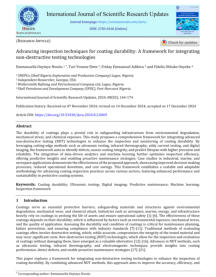
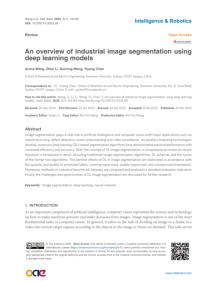
Among the many documents on underwater construction techniques
and procedures added to our database, the following papers illustrate
the use of computation in the construction industry and highlight the
potential of these technologies to address various challenges, such as
the durability and behavior of structures exposed to harsh conditions.
"The impact of platform motion on the
aerodynamic characteristics of floating
offshore wind turbine arrays", by Xiang Li,
Qing Xiao, and Yang Huang, is a study that
examines how platform motion affects the
aerodynamic characteristics of floating
offshore wind turbine arrays using a
high-fidelity numerical tool developed from
open-source software.
The paper by Tianyu Liu, Feng Diao, Wen Yao
and Gang Xu, "Study on Motion Response
Prediction of Offshore Platform Based on
Multiple Sea States and EMD Algorithm," is a
study in which specific software is used to
evaluate platform responses to different wave
directions and heights to improve the
prediction of dynamic responses of offshore
structures.
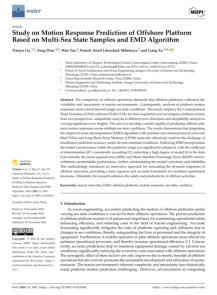


Courtesy of Fabrice Pipault
Autonomous Underwater Vehicles (AUVs) are now widely utilized for
various tasks, including seabed mapping, monitoring underwater
infrastructure, locating wrecks, studying ocean conditions, conducting
environmental assessments like water quality, and more.
This article discusses the advantages and disadvantages of using
AUVs, which can be carried by a maximum of two people.
A list of machines that can be taken as references, along with the
contact details of their manufacturers, is included to highlight
differences in design and performance, facilitating a better
understanding of available options and enabling improved selection
based on the operations undertaken by companies.
Light Autonomous Underwater Vehicles (AUVs)


Note the documents “BMP Maritime Security” and “Maritime Industry
Security Treat Overview (MISTO)” below, which have been edited with
the support of most of the organizations listed in this section. Applying
the recommendations from these documents will:
•
Assist in planning voyages and offshore activities.
•
Improve understanding of marine threats and their impacts.
•
Reduce the likelihood of involvement in a maritime security incident.
•
Help determine mitigations to keep the crew and ship safe.
•
Provide reference information sources.
•
Specify contacts and reporting procedures for emergencies and
welfare assistance.
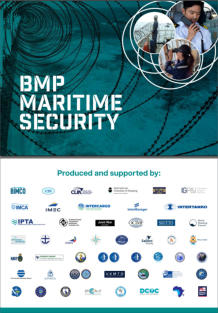
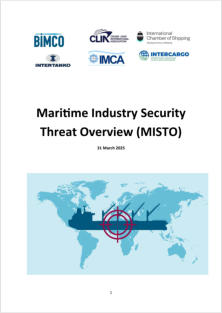

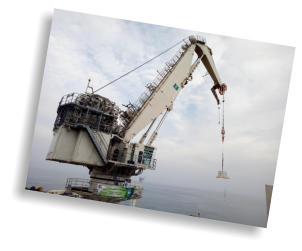

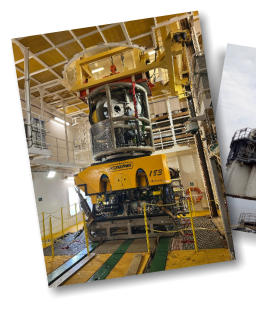



This discussion highlights the need to go beyond mandatory standards
and professional organization guidelines in documenting company
manuals and procedures. In addition to highlighting the risks of not
having documentation that explains the rationale for standards and
guidelines and why the company chooses them, it provides a list of
for-profit and not-for-profit organizations that publish scientific and
technical papers that can be used for this purpose, in addition to our
database, accessible by clicking on the "document" button in the
navigation bar.
Click on the button below to open this post.
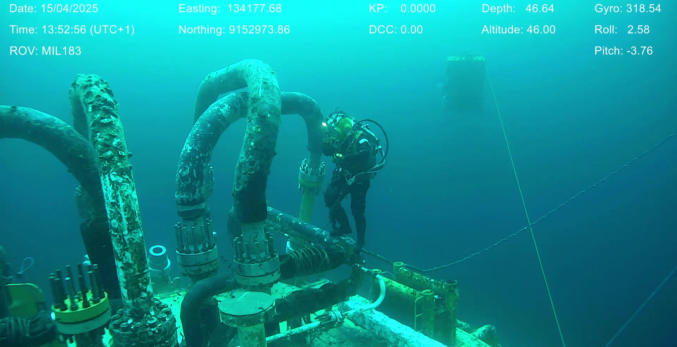
Courtesy of Fabrice Pipault
Diving Management Studies CCO Ltd:
The "Diving Management Studies" CCO Ltd. (red cover) covers specific topics related
to diving and ROV operations. This series of documents was initiated prior to the
creation of the website, and the name has been retained to distinguish these
documents from the manuals.
This document discusses the problems posed by the
organization of continuous diving and the limits of such
operations
Study CCO Ltd No 1:
Organize air & nitrox continuous diving operations.
Study CCO Ltd No 2:
Organize the maintenance of diving cylinders.
This document discusses the problems posed by the
maintenance of diving cylinders.
Study CCO Ltd No 3:
Implement a drug and alcohol abuse policy.
This document discusses the problems posed by drug and alcohol in
a company. Note that it promotes procedures that are the opposite
of a lot of company policies regarding the methods to be in place to
manage such issues.
Study CCO Ltd No 4:
Strengthen the US Navy saturation diving procedures
This document demonstrates that a proper reinforcement of the
US Navy procedures is possible using publications from
recognized competent bodies and that reinforcements made
empirically are not suitable.
Study CCO Ltd No 5:
Implement NORMAM-15/DPC saturation diving
procedures.
NORMAM-15/DPC procedures allow safe hyperbaric exposures
up to 350 m and are adopted by the Brazilian Navy
This study also indicates the latest standards that can be
implemented to reinforce this table.
Study CCO Ltd No 6:
Reflections regarding umbilical lengths when diving
from a DP vessel.
This document explains calculation methods that solve the
problems not taken into account by the procedures from IMCA
and ADCI regarding the safe distance of divers from propellers
and other hazards when diving from a dynamic positioning
vessel.
Document Diving & ROV Specialists:
Description of a saturation diving system.
This document describes a saturation diving system in full and
indicates the management system that should be in place to
maintain it.
Saturation diving handbook
This manual, which comprises four documents and an appendix,
is a compilation of elements from the following three publications
and other scientific and technical documents:
- The Saturation Diving Manual by CCO Ltd.
- The Diving Study #5.
- The document "Diving & ROV Specialists: Description of a
Saturation System”.
Study CCO Ltd No 7:
History and evaluation of IMCA D 050 rev. 1.1 -
Minimum quantities of gas requiered offshore.
This study evaluates this new revision of IMCA D 050.
Study CCO Ltd No 8:
Set a policy for electronic devices in chambers.
This document highlights the safety risks associated with using
digital electronic devices in hyperbaric chambers and advocates
for the implementation of rules and regulations to mitigate these
risks.
Study CCO Ltd No 9:
Analysis of the document IOGP 411 rev. 2021
Recommended practices for diving operations.
This study analyzes the document IOGP 411 and questions
whether it can be considered a reference for diving practices, as
its publishers claim.
Study CCO Ltd No 10:
working at height during the mobilization and the
maintenance of diving and ROV systems.
This document has been created in response to reports from
client representatives showing that numerous mistakes are made
regarding work at height during the mobilization and the
maintenance of diving and ROV systems.
Study CCO Ltd No 11:
About pre-dive conditioning and commercial diving.
“Pre-dive conditioning” refers to experimental studies made to
demonstrate that preparation of the diver through exercises,
oxygen, substances uptake, or other methods before the
immersion has beneficial effects on decompression.
This handbook is, for the moment, composed of 3 books:
1.
Description and prevention of diving accidents.
2.
Elements for preparation.
3.
Air & nitrox diving using in-water and surface
decompression.
Surface supplied diving using MT92/2019 tables
Study CCO Ltd No 12:
Aout standards.
This study is the PDF version of an article published in HTML
format on the website in the Section “Food for thought”.
Basic rigging and lifting procedures handbook
This document promotes the essential principles for organizing
the lifting of various loads to diving & ROV teams for the
operations they may undertake during the construction projects
they are involved in. It is based on national and international
standards and guidelines such as ISO, EN, ASME, ASTM, OSHA,
and HSE standards. Other norms are also used occasionally.
Manuals “Diving and ROV Specialists”:
As previously mentioned, these manuals are based on scientific documents, relevant
standards, and guidelines. Most are available in our database, while others are not
free of charge and must be purchased.
Surface supplied diving using DCIEM tables
This handbook is, for the moment, composed of 3 books:
1.
Description and prevention of diving accidents.
2.
Elements for preparation.
3.
Air & nitrox diving using in-water and surface
decompression.
Year 2020
•
Machine learning for modeling animal movement
Authors: Dhanushi A. Wijeyakulasuriya, Elizabeth W. Eisenhauer, Benjamin A.
Shaby, Ephraim M. Hanks
Year 2024 - part A
•
Obstacles Detection in Underwater Environment Using ROV Based on
Convolutional Neural Network.
Authors: Purwidi Asri, Yuning Widiarti, Endang Pudji Purwanti, Endah Wismawati,
M. Firman Tsany Arifin
•
Implementation of miniaturized power transmission system of ROV
Authors: Mingyu Yang, Shiyu Zhao, Yixuan Tong and Guangyu Lu
•
Numerical simulation of hydrodynamics of ocean-observation-used remotely
operated vehicle.
Authors: Dapeng Zhang, Bowen Zhao, Yi Zhang, and Nan Zhou
•
Multi-AUV Based Underwater Target Tracking Method via Reinforcement Learning
in Dynamic Ocean Environment.
Authors: Tianxiang Xing, Jingzehua Xu, Jun Du, Xiangwang Hou, Tianyu Xing,
Yong Ren.
•
Embracing the future: the rise of humanoid robots and embodied AI.
Authors: Jiankun Wang, Chaoqun Wang, Weinan Chen, Qi Dou, Wenzheng Chi
•
Ego-to-Exo: Interfacing Third Person Visuals from Egocentric Views in Real-time for
Improved ROV Teleoperation.
Authors: Adnan Abdullah, Ruo Chen, Ioannis Rekleitis, and Md Jahidul Islam
•
Parameter identification of an open-frame underwater vehicle based on numerical
simulation and quantum particle swarm optimization.
Authors: Mingzhi Chen, Yuan Liu, Daqi Zhu, Anfeng Shen, Chao Wang, Kaimin.
Year 2024 - Part B
•
A Method for Multi-AUV Cooperative Area Search in Unknown Environment Based
on Reinforcement Learning.
Authors: Yueming Li, Mingquan Ma, Jian Cao, Guobin Luo, Depeng Wang and
Weiqiang Chen
•
Model Reference Adaptive Control based on Neural Network for Depth of an AUV.
Authors: Fatima Zohra Kadri, Rachida Ghoul Hadiby, Kadda Boumediene, Yasmine
Derkaoui, Bachir Daaou, Aicha Djellouli
•
MIT Sea Beaver II - Presentation
Authors: Supun Randeni, Michael Sacarny and Michael Benjamin
•
Affordable 3D Orientation Visualization Solution for Working Class Remotely
Operated Vehicles (ROV).
Authors: Mohammad Afi f Kasno, Izzat Nadzmi Yahaya, and Jin-Woo Jung
•
Autonomous Visual Fish Pen Inspections for Estimating the State of Biofouling
Buildup Using ROV - Extended Abstract.
Authors: Matej Fabijanic, Nadir Kapetanovic, & Nikola Miškovic
•
AUV path planning based on improved IFDS and deep reinforcement learning.
Authors: Fan Yiqun, Li Hongna, Xie Jiaqi, and Zhou Yunfu
•
Modelling of ROV-Operated Disconnectable Mooring Systems in Wave Dominated
Environments.
Authors: Jonathan Glasspool, Francesco Giorgio-Serchi, Ajit C. Pillai
•
Quantitative Comparison of ROV and Diver-Based Photogrammetry to Reconstruct
Maerl Bed Ecosystems.
Authors: Iona L. R. Paterson, Kathryn E. Dawson, Andrew O. M. Mogg, Martin
D. J. Sayer, Heidi L. Burdett
•
Comparison of a tower geodetic micro-network optimization results obtained using
the MABAC, MAIRCA, COCOSO and ROV methods with those obtained applying
the VIKOR method.
Author: Darko Andie
•
A Hierarchical Planning Method for AUV Search Tasks Based on the Snake
Optimization Algorithm.
Authors: Zhiwen Wen, Zhong Wang, Xiangdong Wen, Chenxi Niu, Pei Wang, and
Daming Zhou.
•
Design and Computational Modelling of AUV Tunnel Thruster Covers for Effi cient
Operation.
Authors: Christopher McNeill, Zachary Cooper-Baldock, and Karl Sammut.
•
Allocation Strategy Optimization Using Repulsion-Enhanced Quantum Particle
Swarm Optimization for Multi-AUV Systems.
Authors: Changjian Lin, Dan Yu, and Shibo Lin
•
Kalypso: An inspection AUV for aquaculture.
Authors: Nikolaos Manos, Ergina Kavallieratou, Nikos Vasilopoulos.
•
Remote Piloting Development of an ROV.
Authors: Jefferson Osowsky, Tin Muskardin, Leonardo M. Barreira
•
USV-AUV Collaboration Framework for Underwater Tasks under Extreme Sea
Conditions.
Authors: Jingzehua Xu, Guanwen Xie, Xinqi Wang, Yimian Ding, Shuai Zhang
Year 2021
•
Review of machine learning methods in soft robotics
Authors: Daekyum Kim, Sang-Hun Kim, Taekyoung Kim, Brian Byunghyun Kang,
Minhyuk Lee, Wookeun Park, Subyeong Ku, DongWook Kim, Junghan
Kwon, Hochang Lee, Joonbum Bae, Yong-Lae Park, Kyu-Jin Cho, Sungho
Jo
•
Autonomous navigation in unknown environment using sliding mode SLAM and
genetic algorithm.
Authors: Salvador Ortiz, Wen Yu
Year 2022 - part B
•
Model Establishment and Parameter Identification of Remotely Operated Vehicle
(ROV).
Authors: Yelei Zhang, Baoji Yin, Huifeng Jiao, Jian Zhang, and Fei Yan
•
Increasing the autonomy of an underwater ROV.
Authors: Marko Vuksic, Tonko Kovacevic, Barbara Dzaja, Predrag Dukie, Slaven Sitie,
Hai Nam Tran, Vincent Rodin, Laurent Lemarchand, Valérie-Anne Nicolas,
Alain Plantec, Stéphane Rubini, Frank Singhoff.
•
A Low-Delay Source-Location-Privacy Protection Scheme with Multi-AUV
Collaboration for Underwater Acoustic Sensor Networks.
Authors: Xiaojing Tian, Xiujuan Du, Xiuxiu Liu, Lijuan Wang, Lei Zhao
Year 2023 - Part A
•
Formation control of multiple autonomous underwater vehicles: a review.
Authors: Tao Yan, Zhe Xu, Simon X. Yang, S. Andrew Gadsden.
Year 2023 - Part B
•
Deep learning-based scene understanding for autonomous robots: a survey.
Authors: Jianjun Ni, Yan Chen, Guangyi Tang, Jiamei Shi, Weidong Cao, Pengfei
Shi
Year 2025
•
Coverage path planning for multi-AUV considering ocean currents and sonar
performance.
Author: Xukai Mu and Wei Gao
•
Dynamic Target Hunting Under Autonomous Underwater Vehicle (AUV) Motion
Planning Based on Improved Dynamic Window Approach (DWA).
Authors: Juan Li, Houtong Lu, Honghan Zhang, and Zihao Zhang
•
A novel real-time intelligent detector for monitoring UAVs in live-line operation on
10 kV distribution networks.
Authors: Haibo Duan, Fanrong Shi, Bo Gao, Yingyue Zhou, Qiushi Cui
•
Stackelberg game-based anti-disturbance control for unmanned surface vessels via
integrative reinforcement learning.
Authors: Yizhen Meng, Chun Liu, Jing Zhao, Jing Huang, Guanbo Jing.
•
Design and Performance Verification of A-HFM Signals for Simultaneous Frame
Detection, Cell ID Assignment, and Doppler Estimation in AUVs Using Multiple
Surface Buoys.
Authors: Sae-Yong Park, Tae-Geon Chung, and Tae-Ho Im
•
ROV Teleoperation in the Presence of Cross-Currents Using Soft Haptics.
Author: Joshua Brown, Ildar Farkhatdinov, Michael Jenkin.
•
Hydrodynamics Model Identification and Model-Based Control Application of a
New Type of AUV.
Authors: Lunyang Lin, Yuxiang Chen, Hong Xiong, Chunliang Yu, Hong Zhu,
Yiyang Xing, and Guodong Zheng.
•
Implementation of ROV control from onshore bases: an innovative approach to
subsea inspections and interventions.
Authors: Lucas dos Anjos Cristiano Marino, Hernandes Coutinho Fagundes,
Vinicius Guedes Gusmão
•
Editorial: Task cognition and planning for service robots.
Authors: Yongcheng Cui, Ying Zhang, Cui-Hua Zhang, Simon X. Yang
•
Security of AUV-carried OIRS-assisted quantum key distribution links in underwater
channels subject to misalignment.
Authors: Weina Pang, Ping Wang, Bo Bai, Wenwen Chen, Shuang Li, and Kaile
Wang
•
Cooperative control for a ROV-based deep-sea mining vehicle with learned
uncertain nonlinear dynamics.
Authors: Yuheng Chen, Haicheng Zhang, Weisheng Zou, Haihua Zhang, Daolin
Xu
•
Model-Based Offline Reinforcement Learning for AUV Path-Following Under
Unknown Ocean Currents with Limited Data.
Authors: Xinmao Li, Lingbo Geng, Kaizhou Liu, and Yifeng Zhao
•
Target pursuit for multi-AUV system: zero-sum stochastic game with WoLF-PHC
assisted.
Authors: Le Hong, Weicheng Cui
•
Multi-Agent Generative Adversarial Interactive Self-Imitation Learning for AUV
Formation Control and Obstacle Avoidance.
Authors: Zheng Fang, Tianhao Chen, Tian Shen, Dong Jiang, Zheng Zhang, and
Guangliang Li

Cultural activities
Page 3 of 6
•
Hitech offshore jacket installation aids.
Publisher: Hi-tech elastomers LTD
•
IRM pile gripper
Publisher: IRM - Offshore and Marine engineers PVT Ltd
•
Offshore platform construction by sivakumar nadraja
Publisher: Sivakumar Nadraja
Page 4 of 6
•
Air lubrication for shipping
Publisher: Silverstream technologies
•
Pascal tech air lubrication
Pascal technologies AS
•
Pascal airhull technology
Publisher: Pascal technologies AS
Website Architecture:
We aim to facilitate effortless information retrieval for our
readers. To achieve this, we have maintained a conventional
navigation bar at the top of every page, presenting five primary
categories that lead to subcategories, as shown in the schematic
below. Sliding menus are also incorporated into subsections
containing multiple pages or topics. Moreover, anchor tags are
used on each topic's page to enable easy navigation to its other
related pages. Additionally, the site offers a wealth of hyperlinks
for downloading documents and accessing other websites.
Years 2005
•
Counterdiffusion Diving: Using Isobaric Mix Switching To Reduce Decompression
Time
Author: Glenn H. Taylor
•
The Risk of Decompression Sickness (DCS) is Influenced by Dive Conditions
Authors: Richard D. Vann, Petar J. Denoble, Donna M. Uguccioni, Neal W. Pollock,
John J. Freiberger, Carl F. Pieper, W.A. Gerth, and Robert Forbes.
•
Reverse dive profiles: the making of a myth
Authors: Carl Edmonds, Stephanie McInnes and Michael Bennett.
•
Venomous Jellyfish of the word.
Author: Paul J Fenner
•
The rate of decompression sickness in scientific diving at the Australian Institute of
Marine Science (Townsville) 1996 to 2001.
Authors: Anthony Carter, Reinhold Muller and Angus Thompson
•
The clinical incidence of central nervous system oxygen toxicity at 284 kPa (2.8
ATA)
Authors: David Wilkinson, Sally Wright and Steven Goble
•
The international safety record for scientific diving.
Author: Martin Sayer
Years 1960 to 1975
•
Panel On Science and Technology eleventh meeting - The management of
information & knowledge
Years 1976 to 1979
•
The kangaroo rat as a model for Type I decompression sickness
Author: BA Hills, BD Butler
Years 1980 to 1985
•
Gastrointestinal Barotrauma
Author: Kenneth W. Kizer
•
Surfactants identified in synovial fluid and their ability to act as boundary lubricants.
Authors: B.A Hills, & B.D. Butler
Years 1986 to 1989
•
SOX” Surface decompression Tables in the Eastern Scheldt
Author: W Sterk
•
Hydra VIII: Pre-commercial Hydrogen Diving Project. In SUT Subtech, pp. SUT-
AUTOE-v14-107. SUT
Authors: Imbert JP, Gortan C, Fructus X, Ciesielski T & Gardette B.
•
Theory of oxygen transport to tissue.
Author: Aleksander S. Popel
Years 1990 to 1995
•
Effect of inert gas switching at depth on decompression outcome in rats
Authors: R.S. Lillo, M.E. MacCallum
•
Short and repetitive decompression in air diving procedures: The commercial
diving experience.
Authors: JP Imbert, X. Fructus, S. Montbarbon
•
The Netherlands national diving center database
Authors: W Sterk
Years 2000 to 2002
•
A mathematical model of diffusion-limited gas bubble dynamics in tissue with
varying diffusion region thickness.
Authors: R. Srini Srinivasan, Wayne A. Gerth, Michael R. Powell
•
Modelling and Validation of Treatment Tables for Severe Decompression Accidents
Authors: Valerie Flook, Ronald Nishi, Aaron Khan
•
Insights on Deep Bounce Dive Safety From the Technical Diving community.
Author: Richard L. Pyle
•
Validation of decompression tables.
Authors: Ryszard KLlos, Ron Nishi, Roman Olszanski
•
Development and validation of 1.3 ata PO2-in-He Decompression tables for the MK
16 Mod 1 UBA.
Authors: Wayne A. Gerth, Thomas M. Johnson
Year 2006
•
La plongée: pression barométrique et mécanismes neurochimiques.
Authors: Jean-Claude Rostain & Norbert Balon
Years 1996 to 1998
•
Evolution and offshore performances of the Comex Treatment Tables. In Workshop
on Decompression Illness Treatment - Undersea Biomedical Hyperbaric Society,
Palm Beach, Florida.
•
Calculating Decompression in Naval Special Warfare SEAL Delivery Vehicle Diving
Operations Utilizing the Real Time Dive Planner.
Authors: D. J. Valaik, E. C. Parker, S. S. Survanshi
•
Cohort study of multiple brain lesions in sport divers: Role of a patent foramen
ovale.
Authors: Michael Knauth, Stefan Ries, Stefan Pohimann, Tina Kerby, Michael
Forsting, Michael Daffertshofer, Michael Hennerici, Klaus Sartor
•
Concervative management of gastric rupture following scuba diving
Authors: J D Hunter, C A Roobottom, Ph Bryson, C Brown
•
The Importance of Deep Safety Stops: Rethinking Ascent Patterns From
Decompression Dives.
Author: Richard L. Pyle
•
DCI incidence for surD NDC tables in the range of 48 to 51 metres
Authors: W. Sterkl, N. vinré, and R. Takashima
•
Diving and the risk of barotrauma.
Author: Erich W Russi
Year 2007
•
Pulmonary effects of submerged oxygen breathing in resting divers: repeated
exposures to 140 kPa.
Author: Barbara Shykoff
Year 2008
•
Acute ischemic colitis during scuba diving: Report of a unique case
Authors: Konstantinos Goumas, Androniki Poulou, Ioannis Tyrmpas, Dimitrios
Dandakis, Stavros Bartzokis, Magdalini Tsamouri, Kalipso Barbati, Dimitrios
Soutos
•
Relation Between Right-to-Left Shunts and Spinal Cord Decompression Sickness in
Divers
Authors: Emmanuel Gemp, Jean Eric Blatteau, Eric Stephan, Pierre Louge
•
Scuba Diving Increases Erythrocyte and Plasma Antioxidant Defenses and Spares
NO without Oxidative Damage.
Authors: Antoni Sureda, Miguel D. Ferrer, Joan M. Batle, Pedro Tauler, Josep A. Tur,
and Antoni Pons
•
Scuba Diving Increases Erythrocyte and Plasma Antioxidant Defenses and Spares
NO without Oxidative AQ1 Damage Diving Increases Erythrocyte and Plasma
Antioxidant Defenses and Spare.
Authors: Antonio Sureda, Miguel Ferrero, Joan Batle, Pedro Tauler, Josep A. Tur,
and Antonio Pons
Year 2009
•
On Validation of a Popular Sport Diving Decompression Model
Authors: B.R. Wienke
•
Endothelial Function and Stress Response After Simulated Dives to 18 msw
Breathing Air or Oxygen.
Authors: Leigh A. Madden, Bryna C. Chrismas, Duane Mellor, Rebecca V. Vince,
Adrian W. Midgley, Lars R. McNaughton, Stephen L. Atkin, and Gerard
Laden
•
Bubble-induced platelet aggregation in a rat model of decompression sickness.
Authors: Jean-Michel Pontier, Nicolas Vallee, and Lionel Bourdon
Year 2011
•
The influence of a hyperbaric environment and increased oxygen partial pressure
on the corrosion of dental alloys.
Authors: Christian Mehl, Frank Heblich, Rudolf Lenz, Klaus Ludwig and Matthias
Kern
•
Maintenance of negative-pressure wound therapy while undergoing hyperbaric
oxygen therapy.
Authors: Si Jack Chong, Meng Kwan Tan, Weihao Liang, Soo Joang Kim and Chai
Rick Soh
•
The need for optimisation of post-dive ultrasound monitoring to properly evaluate
the evolution of venous gas emboli.
Authors: S Lesley Blogg, and Mikael Gennser
•
Retinal artery occlusion: visual outcome after treatment with hyperbaric oxygen.
Authors: Austin Cope, Joan V Eggert and Erin O’Brien
•
Risk factors and clinical outcome in military divers with neurological decompression
sickness: influence of time to recompression.
Authors: Jean-Eric Blatteau, Emmanuel Gempp, Pascal Constantin and Pierre Louge
•
Preventing Decompression Sickness Over Three Decades of Extravehicular Activity.
Author: Johnny Conkin)
•
Dive Computer Program Management in Scientific Diving
Author: Michael A. Lang
•
Dive Computer Use in Recreational Diving: Insights from the DAN-DSL Database
Author: Costantino Balestra
•
The Use of Venous Gas Emboli to Validate Dive Computers.
Authors: S Lesley Blogg, Andreas Mollerlokken
•
Validation of Dive Computer Algorithms
Author: Sergio A. Angelini
•
US Navy dive computer validation
Authors: David J. Doolette, Keith A. Gault, Wayne A. Gerth, F. Greg Murphy
•
Dive Computers: The Need for Validation and Standards
Authors: Arne Sieber, Milena Stoianova, Ewald Jobstl, Alaine Azzopardi, Martin DJ
Sayer, Matthias F. Wagner
•
Dive computer considerations
Author: Karl E Huggins
•
Dive computer validation procedures
Author: RW Bill Hamilton
•
Proceedings of Validation of Dive Computers Workshop
Publisher: European Underwater and Baromedical Society
•
Advances in diagnosis and treatment of cerebral arterial gas embolism
Author: Robert Weenink
•
Surface nanobubbles as a function of gas type.
Authors: Michiel A. J. van Limbeek, and James R. T. Seddon
•
British Sub-Aqua Club (BSAC) diving incidents report 2010
Author: Brian Cumming
•
Ward’s Hierarchical Clustering Method: Clustering Criterion and Agglomerative
Algorithm.
Authors: Fionn Murtagh, and Pierre Legendre
Year 2012
•
Animal models of cerebral arterial gas embolism
Authors: Robert P. Weenink, Markus W. Hollmann, Robert A. van Hulst
•
Severe capillary leak syndrome after inner ear decompression sickness in a
recreational scuba diver.
Publisher: Emmanuel Gempp, Guillaume Lacroix, Jean-Marie Cournac, and Pierre
Louge
•
Abdominal compartment syndrome caused by tension pneumoperitoneum in a
scuba diver.
Authors: J Bunni , PJ Bryson, SM Higgs
•
Decompression calculations for trimix dives with PC software: variations in the time-
to-surface: where do they come from?
Author: Albrecht Salm
•
Intramicroparticle nitrogen dioxide is a bubble nucleation site leading to
decompression-induced neutrophil activation and vascular injury.
Authors: Stephen R. Thom, Ming Yang, Veena M. Bhopale, Tatyana N. Milovanova,
Marina Bogush, and Donald G. Buerk
Year 2013
•
Patent foramen ovale and scuba diving: a practical guide for physicians on when
to refer for screening.
Authors: Oliver Sykes, and James E Clark
•
Influence of repeated daily diving on decompression stress.
Authors: Neal W. Pollock, Jaksa Zanchi, Marko Ljubkovic, Petar J. Denoble, Zeljko
Dujic, Shabbar I. Ranapurwala.
•
A critical review of physiological bubble formation in hyperbaric decompression.
Authors: Virginie Papadopoulou, Robert J. Eckersley, Costantino Balestra, Thodoris
D. Karapantsios, Meng-Xing Tang
•
Exercise after SCUBA diving increases the incidence of arterial gas embolism.
Authors: Dennis Madden, Mislav Lozo, Zeljko Dujic, and Marko Ljubkovic
•
Influence of Repeated Daily Diving on Decompression Stress.
Authors: J. Zanchi, M. Ljubkovic , P. J. Denoble, Z. Dujic, S. Ranapurwala, N. W.
Pollock
•
Mathematical Models of Diffusion-Limited Gas Bubble Evolution in Perfused Tissue.
Authors: Ramachandra Srini Srinivasan, Wayne A. Gerth
•
Barodontalgias, dental and orofacial barotraumas.
Authors: Cristina Zanotta, Dorothea Dagassan, Peter Nussberger, Tuomas Waltimo,
Andrea Filippi
Year 2004
•
Risk of decompression illness among 230 divers in relation to the presence and size
of patent foramen ovale.
Authors: Sandra Rea Torti, Michael Billinger, Markus Schwerzmann, Rolf Vogel,
Rainer Zbinden, Stephan Windecker, Christian Seiler
•
Co-ordinated investigation into the possible long term health effects of diving at
work Examination of the long term health impact of diving: The ELTHI diving study
- Research report 230
•
Graphical analysis: Decompression tables and dive-outcome data
Authors: H.D. Van Liew, & E.T. Flynn
Year 2010
•
Decompression Illness Medically Reported by Hyperbaric Treatment Facilities:
Cluster Analysis of 1929 Cases.
Authors: Tamer Ozyigit, Salih Murat Egi, Petar Denoble, Costantino Balestra, Salih
Aydin, Richard Vann, and Alessandro Marroni
•
Successive deep dives impair endothelial function and enhance oxidative stress in
man.
Authors: Ante Obad, Jasna Marinovic, Marko Ljubkovic, Toni Breskovic, Darko
Modun, Mladen Boban, and Zeljko Dujic.
•
Thalmann Algorithm Decompression Table Generation Software Design
Document.
Author: Wayne a. Gerth
Year 2025
•
Cellular Mechanisms of Oxygen Transport Hemoglobin Dynamics
Authors: Indunil Karunarathna, Sanjeewa Dius, R Ranwala, Sau Bandara, Sanjaya
Godage, PN Rodrigo, Asoka Jayawardana, U Vidanagama, Cam
Fernando, Upul Ekanayake, T Hapuarachchi, Prasanna Gunasena, P
Aluthge, Nihal Perera , Senaka Gunathilake, Kapila De Alvis , Kapila
Gunawardana, Samadi Rajapaksha, A Warnakulasooriya , P Athulgama
•
Machine learning approach to student performance prediction of online learning.
Authors: Jing Wang, Yun Yu
•
Therapeutic delivery of oxygen using artificial oxygen carriers demonstrates
the possibility of treating a wide range of diseases.
Authors: Nijaya Mohanto, Himangsu Monda, Young-Joon Park, and Jun-Pil Jee
•
An Overview of Rebreather Trimix Diving Practices in France and Self-reported
Accidentology.
Authors: E. Gouin, F. Guerrero, J-É. Blatteau
Year 2019
•
Bubble Solution Description by Non-Extensive Thermodynamics: Pressure Eff ect
Authors: Pierre Letellier, Mireille Turmine
•
A new form of admissible pressure for Haldanian decompression models
Authors: Alexis Blasselle, Michael Theron, Bernard Gardette, Emmanuel Dugrenot
•
Risks from Breathing Elevated Oxygen.
Author: Barbara E. Shykoff, Rees L. Lee
Year 2020
•
Reverse Squeeze Maxillary Sinus Barotrauma
Authors: Rasads Misirovs, and Shwan Mohamad,
•
Livedo Racemosa – The Pathophysiology of Decompression-Associated Cutis
Marmorata and Right/Left Shunt
Authors: Frank Hartig, Norbert Reider, Martin Sojer, Alexander Hammer, Thomas
Ploner, Claus-Martin Muth, Herbert Tilg, and Andrea Köhler
•
Gas in Joints After Diving: Computed Tomography May Be Useful for Diagnosing
Decompression Sickness.
Authors: Kei Jitsuiki, Yoshihiro Kushida, Ryota Nishio, Youichi Yanagawa
•
Pre-hydration strongly reduces decompression sickness occurrence after a
simulated dive in the rat.
Authors: Qiong Wang, François Guerrero, Michaël Theron
•
Cutis marmorata as a manifestation of decompression illness
Authors: Antonio Villa, Mara Fiocchi
•
Decompression illness treated at the Geneva hyperbaric facility 2010–2016: A
retrospective analysis of local cases.
Authors: Julian Thaler, Rodrigue Pignel, Marie-Anne Magnan, Michel Pellegrini,
Pierre Louge
Year 2024 - Part B
•
Taravana syndrome and posterior reversible encephalopathy syndrome: a
microbubble hypothesis for neurological accidents in breath-hold divers.
Authors: Arnaud Druelle, Olivier Castagna, Romain Roffi, Pierre Louge, Anthony
Faivre, and Jean-Eric Blatteau
•
Induction of Cerebral Arterial Gas Embolism in Rat
Authors: Raoul A. Fakkert, Nina C. Weber, Benedikt Preckel, Robert A. van Hulst,
Inge A. Mulder, Robert P. Weenink
•
Utility of Raman Spectroscopy in Pulmonary Medicine.
Author: Pauls Dzelve, Arta Legzdin, Andra Krumina, and Madara Tirzıte
•
Are Exercise-Induced Premature Ventricular Contractions Associated with
Significant Coronary Artery Disease?
Author: Sok-Sithikun Bun, Clementine Massimelli, Didier Scarlatti, Fabien Squara and
Emile Ferrari
•
N2 exchanges in hyperbaric environments: toward a model based on physiological
gas transport (O2 and CO2)
Authors: Michael Theron, Alexis Blasselle, Lisa Nedellec, Pascal Ballet, Emmanuel
Dugrenot, Bernard Gardette, François Guerrero, Anne Henckes, and
Jean-Pierre Pennec
•
Patent Foramen Ovale (PFO) and Decompression Sickness
Authors: Douglas Ebersole
Year 2021 - Part A
•
Predicting the effect of decompression sickness on survival following submarine
tower escape
Authors: Geoff A.M. Loveman, & Joel J.E. Edney
•
Middle ear barotrauma in diving
Author: Oskari H Lindfors, Anne K Räisänen-Sokolowski, Jari Suvilehto, Saku T
Sinkkonen
•
The Chemistry of Reactive Oxygen Species (ROS) Revisited: Outlining Their Role in
Biological Macromolecules (DNA, Lipids and Proteins) and Induced Pathologies.
Authors: Celia Andrés Juan, José Manuel Pérez de la Lastra, Francisco J. Plou, and
Eduardo Pérez-Lebeña
•
Oxygen-derived free radicals: Production, biological importance, bioimaging, and
analytical detection with responsive luminescent nanoprobes.
Authors: Jianping Liu, Miaomiao Wu, Run Zhang, Zhi Ping Xu
•
Diving-related disorders in commercial breath-hold divers (Ama) of Japan.
Authors: Kiyotaka Kohshi, Hideki Tamaki, Frédéric Lemaître, Yoshitaka Morimatsu,
Petar J Denoble, Tatsuya Ishitake
Year 2021 - Part B
•
Effect of Water Amount Intake before Scuba Diving on the Risk of Decompression
Sickness.
Authors: Kil-Hyung Han, Gwang-Suk Hyun, Yong-Seok Jee, and Jung-Min Park
•
Heart Rate and Muscle Oxygenation Kinetics During Dynamic Constant Load
Intermittent Breath-Holds.
Authors: Janne Bouten, Sander De Bock, Gil Bourgois, Sarah de Jager, Jasmien
Dumortier, Jan Boone, and Jan G. Bourgois
•
Swim performance with and without snorkel and the underlying energetic
differences
Author: Nico A.M. Schellart
•
Effect of types of resin cements on the bond strength of fiber post under simulated
dives.
Authors: Ting Khee Ho, Mohd Najib Md Razi, Natasya Ahmad Tarib
•
Inner ear decompression sickness in Finland: a retrospective 20-year multicenter
study.
Authors: Oskari H. Lindfors, Richard V. Lundell, Olli J. Arola, Timo P. Hirvonen, Saku
T. Sinkkonen, Anne K. Räisänen-Sokolowski
•
Performance of the Uni-Vent Eagle™ Model 754 ventilator under hyperbaric
conditions.
Authors: Daniel Popa, Lynn Waterhouse, Jay Duchnick, Tom Neuman, Peter
Witucki
•
Treatment outcomes on neovascularization after CRAO treated with hyperbaric
oxygen.
Authors: Nicole Lifson,George Salloum, Philip Kurochkin, Michael Bivona, Han Y.
Yin, Samuel Alpert
•
Repetitive hyperbaric oxygen therapy for paroxysmal sympathetic hyperactivity a er
acute carbon monoxide poisoning.
Authors: Sangchun Choi, Hyuk-Hoon Kim, Seong Beom Oh, Yoon Seok Jung.
•
Inner ear decompression sickness in a hyperbaric chamber inside tender: a case
report.
Authors: Dominique Gelmann, Gregory Jasani, Siamak Moayedi, Douglas Sward
•
Hyperbaric oxygen for thermal burns.
Authors: Paul Cianci, Ronald M. Sato, Julia Faulkner
•
Variability in venous gas emboli following the same dive at 3,658 meters.
Authors: Hayden W. Hess, Courtney E. Wheelock, Erika St. James, Jocelyn L. Stooks,
Brian M. Clemency, David Hostler
•
Effects of Cold Decompression on Hemodynamic Function and Decompression
Sickness Risk in a Dry Diving Rat Model.
Authors: Svein E. Gaustad, Timofei V. Kondratiev, Ingrid Eftedal, and Torkjel Tveita
Year 2022 - Part A
•
Does hyperbaric oxygen therapy facilitate peripheral nerve recovery in upper
extremity injuries? A prospective study of 74 patients.
Authors: Bilsev Ince, Majid Ismayilzada, Abdullah Arslan, Mehmet Dadaci
•
Simulating Multi-Scale Pulmonary Vascular Function by Coupling Computational
Fluid Dynamics With an Anatomic Network Model
Authors: Behdad Shaarbaf Ebrahimi, Haribalan Kumar, Merryn H. Tawhai, Kelly S.
Burrowes, Eric A. Hoffman, and Alys R. Clark
Year 2022 - Part B
•
The role of routine pulmonary imaging before hyperbaric oxygen treatment.
Authors: Connor TA Brenna, Shawn Khan, George Djaiani, Jay C Buckey Jr., Rita
Katznelson
•
Right cardiac chambers echo- bubble contrast in a patient with decompression
sickness: A case report and a literature review.
Authors: Allam Harfoush, Mohammad Ramadan, Hanady Hamdallah
•
Decompression Illness in a Scuba Diver With Significant Esophageal Injury
Authors: Eyal Avivi, Dana Zelnik Yovel, Daniel L. Cohen, and Haim Shirin
•
Inner ear decompression syndrome (IEDCS).
Authors: Muhammad Aulia Hikmah Romadoni, Dwi Rahmat, Eka Arie Yuliyani.
Year 2023 - Part A
•
Neuroinflammation with increased glymphatic flow in a murine model of
decompression sickness.
Authors: Stephen R. Thom, Veena M. Bhopale, Abid R. Bhat, Awadhesh K. Arya,
Deepa Ruhela, Guanda Qiao, Xin Li, Shiyu Tang, and Su Xu.
•
A critical review of physiological bubble formation in hyperbaric decompression
Authors: Virginie Papadopoulou, Robert J. Eckersley, Costantino Balestra, Thodoris
D. Karapantsios, Meng-Xing Tang
•
The risk of decompression illness in breath-hold divers: a systematic Review
Author: S Lesley Blogg, Frauke Tillmans, Peter Lindholm
•
Right-to-Left Shunt in Divers with Neurological Decompression Sickness: A
Systematic Review and Meta-Analysis.
Publishers: Spyros Peppas, Leonidas Palaiodimo, Sanjana Nagraj, Damianos G.
Kokkinidis, Nidhish Tiwari, Amrin Kharawala, Mohammad K. Mojadidi,
Sanauallah Mojaddedi, George Ntaios, Robert T. Faillace, and Jonathan
M. Tobis
Year 2023 - Part B
•
E-Cigarettes and Associated Health Risks: An Update on Cancer Potential.
Authors: Rakesh Sahu, Kamal Shah, Rishabha Malviya, Deepika Paliwal, Sakshi Sagar,
Sudarshan Singh, Bhupendra G. Prajapati, and Sankha Bhattacharya
Year 2017
•
Physical and physiological aspects of submarine tower escape
Author: Geoff A.M. Loveman
•
A comparative evaluation of two decompression procedures for technical diving
using inflammatory responses: compartmental versus ratio deco.
Authors: Enzo Spisni, Claudio Marabotti, Luigia De Fazio, Maria Chiara Valerii, Elena
Cavazza, Stefano Brambilla, Klarida Hoxha, Antonio L’Abbate and
Pasquale Longobardi.
•
A technical diving-related burns case: treatment in a remote location
Authors: Fiona C Sharp, Martin DJ Sayer
•
Reliability of Right-to-Left Shunt screening in the prevention of Scuba diving related-
decompression sickness.
Authors: Emmanuel Gempp, Marianne Lyard, Pierre Louge
Year 2018
•
Variability in circulating gas emboli after a same scuba diving Exposure.
Authors: V. Papadopoulou, P. Germonpré, D. Cosgrove, R. J. Eckersley,
P. A. Dayton, G. Obeid, A. Boutros, M.X. Tang, S. Theunissen, C. Balestra
•
Extravascular Hydrophobic Surfaces, Fat Droplets, and the Connection With
Decompression Illness: Spinal, Joint Pain, and Dysbaric Osteonecrosis.
Author: Ran Arieli
•
Effects of sleep and fatigue on teams in a submarine environment
Author: Sarah Chabal, Rebecca Welles, Lt.Cmdr. F. Jay Haran, Rachel Markwald
•
The Gradient Perfusion Model Part 1: Why and at what sites decompression
sickness can occur.
Authors: Michael B Strauss, Lientra Q Lu, Stuart S. Miller
•
The Gradient Perfusion Model Part 2: Substantiation of the GPM with clinical cases.
Authors: Michael B Strauss, Lientra Q Lu, Stuart S. Miller
•
The Gradient Perfusion Model Part 3: An extraordinary case of decompression
sickness.
Authors: Lientra Q Lu, Michael B Strauss, Stuart S. Miller
•
Blood Gene Expression and Vascular Function Biomarkers in Professional
Saturation Diving.
Authors: Fatima Z. Kiboub, Andreas Møllerløkken, Astrid Hjelde, Arnar Flatberg,
Øyvind Loennechen, and Ingrid Eftedal
•
Indices of Increased Decompression Stress Following Long-Term Bed Rest
Authors: Mikael Gennser, S. L. Blogg, Ola Eiken, and Igor B. Mekjavic
•
Provocative decompression causes diffuse vascular injury in mice mediated by
microparticles containing interleukin-1 Beta.
Authors: Stephen R. Thom, Veena M. Bhopale, Kevin Yu, and Ming Yang
Year 2024 - Part A
•
NDTT – Probability of decompression sickness
Author: Jan Risberg
•
Oxidative Stress and Cerebral Vascular Tone: The Role of Reactive Oxygen and
Nitrogen Species.
Authors: Michele Salvagno, Elda Diletta Sterchele, Mario Zaccarelli, Simona Mrakic-
Sposta, Ian James Welsby, Costantino Balestra, and Fabio Silvio Taccone
•
Safety of Hyperbaric Medicine in Clinical Scenarios
Author: Vishal Mago
•
Barodontalgia and its implications for Navy divers and dentists: A narrative review.
Authors: Javier García-Torres, Juan J. Segura-Egea
Year 2015
•
Decompression induced bubble dynamics on ex-vivo fat and muscle tissue surfaces
with a new experimental set up
Authors: Virginie Papadopoulou, Sotiris Evgenidis, Robert J. Eckersley, Thodoris
Mesimeris, Costantino Balestra, Margaritis Kostoglou, Meng-Xing Tang,
Thodoris D. Karapantsios
•
Cutis marmorata in decompression illness may be cerebrally mediated: a novel
hypothesis on the aetiology of cutis marmorata.
Authors: Tom CPM Kemper, Rienk Rienks, Pieter-Jan AM van Ooij and Rob A van
Hulst
•
Residual oxygen time model for oxygen partial pressure near 130 kPa (1.3 atm)
Author: Barbara shykoff
•
Development of a pulmonary oxygen toxicity risk calculator for repeated dives with
PO2 = 1.3 atm.
Author: Barbara shykoff
Year 2016
•
Otologic Hazards Related to Scuba Diving
Authors: Tiffany A. Glazer, and Steven A. Telian
•
Oxygen, the lung and the diver: friends and foes?
Authors: Pieter-Jan A.M. van Ooij, Peter J. Sterk, and Robert A. van Hulst
Year 2014
•
Microbubbles are detected prior to larger bubbles following decompression
Authors: J. G. Swan, J. C. Wilbur, K. L. Moodie, S. A. Kane, D. A. Knaus, S. D. Phillips,
T. L. Beach, A. M. Fellows, P. J. Magari, and J. C. Buckey.
•
A retrospective cohort study of lidocaine in divers with neurological decompression
illness
Publisher: Robert P. Weenink, Markus W. Hollmann, Astrid Zomervrucht, Pieter-Jan
A.M. van Ooij, Robert A. van Hulst
•
Decompression tables for inside chamber attendants working at altitude.
Author: James Bell, Paul A. Thombs, William J. Davison, Lindell K. Weaver
Diving & ROV procedures and standards
Years 1960 to 2018
•
USSR/Russian Saturation Diving tables
•
UK HSE - A guide to the Work in Compressed Air Regulations 1996 &
2002
•
Canadian department of safety procedures - Underwater diving program.
•
Ministry of defense of the Russian Federation - Organization of deep sea
diving
•
OSHA - 29 CFR Part 1910, Subpart T – Commercial Diving Operations.
•
Korean decompression tables for High-Pressure Work in caisson and
tunneling 2014.
•
US dept of homeland security - Commercial diving operations.
•
Operating Standards for NOAA Hyperbaric Chambers.
Historical Diving
•
Handbook US Navy Diving Operations - 1974
•
ITA Working Group n°5 Health & Safety in Works In Association with the
British Tunnelling Society Compressed Air Working Group - 2017.
Non Destructive Techniques (NDT)
•
A New Computational Imaging Method for the Remote Detection and
Quantification of Hidden Corrosion.
Authors: Dr. John M. Webster. Dr Thanga Thevar. Tim Schmidt. Jackie Mew.
•
The review of non-destructive testing techniques suitable for inspection of the wind
turbine blades.
Authors: R. Raišutis, E. Jasiuniene, R. Šliteris, A. Vladišauskas
•
Effective Guided Wave Technique for Performing Non-destructive Inspection on
Steel Wire Ropes that Hoist Elevators.
Authors: Peter W. Tse and J.M. Chen
•
Multivariate Risk Assessment for Offshore Jacket Platforms by Gaidai Reliability
Method.
Authors: Oleg Gaidai, Yu Cao, Yan Zhu, Fuxi Zhang, and Hongchen Li.
•
Structural damage identification method based on Swin Transformer and
continuous wavelet transform.
Authors: Jingzhou Xin, Guangjiong Tao, Qizhi Tang, Fei Zou, Chenglong Xiang.
•
Hydrogen Absorption and Self-Corrosion of Mg Anode: Influence of Aqueous
Electrolyte Species.
Authors: Andrei Nazarov, Tatiana Yurasova, and Andrey Marshakov.
•
Dynamic modeling and learning based path tracking control for ROV-based deep-
sea mining vehicle.
Authors: Yuheng Chen, Haicheng Zhang, Weisheng Zou, Haihua Zhang, Bin
Zhou, Daolin Xu.
•
Inductive thermography – review of a non-destructive inspection technique for
surface crack detection.
Authors: Beate Oswald-Tranta
•
Advancing inspection techniques for coating durability: A framework for
integrating non-destructive testing technologies.
Authors: Emmanuella Onyinye Nwulu, Tari Yvonne Elete, Friday Emmanuel
Adikwu, and Fidelis Othuke Onyeke
•
Advanced Non-Destructive Testing Techniques for Welded Joint Repairs: A Case
Study on Improving Inspection Reliability and Structural Integrity Assessment
Authors: Mohammadebrahim Bajgholi, Gilles Rousseau, Denis Thibault, Simon
Francoeur
•
Protection Criteria of Cathodically Protected Pipelines Under AC Interference.
Authors: Luca Paterlini, Andrea Marinelli, Andrea Brenna and Marco Ormellese.
•
Natural van der Waals canalization lens for non-destructive nanoelectronic circuit
imaging and inspection.
Authors: Qingdong Ou, Shuwen Xue, Weiliang Ma, Jiong Yang, Guangyuan Si, Lu
Liu, Gang Zhong, Jingying Liu, Zongyuan Xie, Ying Xiao, Kourosh
Kalantar-Zadeh, Xiang Qi, Peining Li, Zhigao Dai, Huanyang Chen,
Qiaoliang Bao
•
Towards quantification of hidden corrosion using D-Sight non-destructive testing
technique.
Authors: Andrzej Katunin, Krzysztof Dragan, Marko Nagode, Krzysztof Lis, Kamil
Joszko, Adam Cholewa, Jernej Klemenc, Simon Oman, Paweł Zak, Piotr
Synaszko
First aid
Years 2022 to 2025
•
Cardiogenic Pulmonary Edema in Emergency Medicine
Authors: Christian Zanza, Francesco Saglietti, Manfredi Tesauro, Yaroslava
Longhitano, Gabriele Savioli, Mario Giosuè Balzanelli, Tatsiana
Romenskaya, Luigi Cofone, Ivano Pindinello, Giulia Racca, and Fabrizio
Racca
•
Psychological First Aid
Authors: Sanjay Kalra, Atul Dhingra, Kumar Abhisheka, Nitin Kapoor
•
First aid training using virtual reality.
Authors: Burapa Phatichon and Chantana Chantrapornchai.
•
Portable oxygen breathing apparatus integrated with biosensors: Enabling
intelligent monitoring and optimal oxygen provision for biomechanical
homeostasis.
Author: Honghao Zhang
•
Exploring knowledge of first aid in epistaxis—25 years on.
Authors: Henry DunneI, Michael Abouabdallah, Joseph Roscamp, Samuel Birks,
Kate Mcgibbon, Sam Dewhurst, David Strachan, Rishi Sharma.
•
Understanding First Aid Skills in Emergency Situations: A Literature Review.
Authors: Irfanita Nurhidayah, Aklima , Riski Amalia, Mariatul Kiftia
Environmental studies
Years 2000 to 2018
•
VRAKA—A Probabilistic Risk Assessment Method for Potentially Polluting Shipwrecks
Authors: Hanna Landquist, Lars Rosén, Andreas Lindhe, and Ida-Maja Hassellöv.
•
Exposure to Crude Oil and Chemical Dispersant May Impact Marine Microbial
Biofilm Composition and Steel Corrosion.
Authors: Jennifer L. Salerno, Brenda Little, Jason Lee, and Leila J. Hamdan.
•
Herbivorous Fish Populations Respond Positively to a Shipwreck Removal and
Associated Alteration of Benthic Habitat.
Author: Kathryn Davis, Peter M. Carlson, and Jennifer E. Caselle.
Years 2024 to 2025
•
Cellular adaptations of the scleractinian coral Madracis pharensis to chronic oil
pollution in a Mediterranean shipwreck.
Authors: Alessandro Nardi, Vasilis Resaikos, Magdalene Papatheodoulou , Marta Di
Carlo, Harini Vedhanarayanan, Francesco Regoli, Stefania Gorbi, and
Carlos Jimenez
•
Artificial structure selection by economically important reef fishes at North Carolina
artificial reefs.
Author: Ryan M. Tharp, Nathan J. Hostetter, Avery B. Paxton, J. Christopher Taylor,
and Jeffrey A. Buckel
•
An Icy Worlds life detection strategy based on Exo-AUV.
Author: Bin Wang, & Hongde Qin.
•
An Assessment of Demersal Elasmobranch Occurrence and Associated Habitats
Using an Autonomous Underwater Vehicle (AUV).
Authors: Jonathon Taylor, John A. Howe, James Thorburn, Clive J. Fox,
Christopher McGonigle, Petra Rybanska
•
Two sides of the same coin: weathering differences of plastic fragments in coastal
environments around the globe.
Authors: Bo Hu, Mui-Choo Jong, João Frias, Irina Chubarenko, Gabriel Enrique De-
la-Torre, Prabhu Kolandhasamy, Md. Jaker Hossain, Elena Esiukova, Lei Su,
Hua Deng, Wenjun Zhao, Yifan Zheng, Huahong Shi
•
Benthic Feeding and Diet Partitioning in Red Sea Mesopelagic Fish Resolved
Through DNA Metabarcoding and ROV Footage.
Author: Kah Kheng Lim, Carlos Angulo-Preckler, Christopher A. Hempel,
Mohammad A. Qurban, Vincent A. Pieribone, Carlos M. Duarte
Underwater mapping
Years 2022 to 2023
•
Present status and challenges of underwater acoustic target recognition
technology: A review.
Authors: Lei Zhufeng, Lei Xiaofang, Wang Na, and Zhang Qingyang
•
An overview of intelligent image segmentation using active contour models.
Authors: Yiyang Chen, Pengqiang Ge, Guina Wang, Guirong Weng, Hongtian
Chen
•
Underwater ice adaptive mapping and reconstruction using autonomous
underwater vehicles.
Authors: Shuangshuang Fan, Xinyu Zhang, Guangxian Zeng, and Xiao Cheng.
Year 2023
•
Experimental and Numerical Study for Gas Release and Dispersion on Offshore
Platforms.
Authors: Fengpu Xiao, Yanan Li, Jun Zhang, Hai Dong, Dongdong Yang, and
Guoming Chen.
•
Reactive power capacity allocation technology of shore-based power supply
system of offshore oil production platform under different network topology
reliability measures.
Authors: Wenle Song, Lei Wang, Xiangyu Hao, Le Wan, Chenyang Li
Year 2022
•
Measurements and Spatial Distribution Simulation of Impact Pile Driving
Underwater Noise Generated During the Construction of Offshore Wind Power
Plant Off the Southwest Coast of Korea.
Authors: Dong-Gyun Han and Jee Woong Choi
•
Historic Wooden Shipwrecks Influence Dispersal of Deep-Sea Bio films.
Authors: Rachel D. Moseley, Justyna J. Hampel, Rachel L. Mugge, and Leila J.
Hamdan
•
80 years later: Marine sediments still influenced by an old war ship
Authors: Joseflen Van Landuyt, Kankana Kundu, Sven Van Haelst, Marijke Neyts,
Koen Parmentier, Maarten De Rijcke, and Nico Boon
•
Potential of Small-wind Turbine for Power Generation on Offshore Oil and Gas
Platforms in Malaysia.
Authors: Chee Sze Yan, Siow Chun Lim, Chan Kah Yoong.

Technical documents - Diving systems
Years 1980 to 2016
•
US Navy: Manned evaluation of the MK14 closed circuit saturation diving system
•
Hyperbaric swimming simulator
Author: Ryszard Kłos
•
Decompression management by 43 models of dive computer: single square-wave
exposures to between 15 and 50 metres’ depth.
Authors: Martin DJ Sayer, Elaine Azzopardi and Arne Sieber
•
User settings on dive computers: reliability in aiding conservative Diving.
Authors: Martin DJ Sayer, Elaine Azzopardi, and Arne Sieber
Years 2017 to 2025
•
Affordable Oxygen Concentrator with PSA Technology
Authors: J. Sofia Bobby, Bharath S, Madhankumar C, Sudharsanam K, and
Ummathullah U
Years 2024 to 2025
•
Learning hybrid dynamic transformers for underwater image super-resolution.
Author: Xin He, Junjie Li, and Tong Jia
•
NeuRSS: Enhancing AUV Localization and Bathymetric Mapping With Neural
Rendering for Sidescan SLAM.
Authors: Yiping Xie , Jun Zhang, Nils Bore, and John Folkesson
•
Monitoring dispersal patterns sea foam injected by offshore platforms using satellite
optical multispectral imagery.
Authors: M. Tedeschi, F. Filipponi, M. Picone, A. Grillo, M. Gabellini, G. Trinchera
•
RUSNet: Robust fish segmentation in underwater videos based on adaptive
selection of optical flow
Authors: Peng Zhang, Zongyi Yang, Hong Yu, Wan Tu, Chencheng Gao, and Yue
Wang
•
Infrared and visible image fusion based on multi-level detail enhancement and
generative adversarial network.
Authors: Xiangrui Tian, Xiaohan Xianyu, Zhimin Li, Tong Xu, Yinjun Jia
•
Remote Awareness of Image Quality for Multi-week Shore-launched AUV Surveys.
Authors: Adrian Bodenmann, Daniel O.B. Jones, Alexander B. Phillips, Robert
Templeton, Rashiid Sherif, Francesco Fanelli, Darryl Newborough, and
Blair Thornton
•
An overview of industrial image segmentation using deep learning models.
Authors: Guina Wang, Zhen Li, Guirong Weng, Yiyang Chen.
•
Cooperative SLAM Algorithm for Multi-AUV Underwater Exploration and Mapping.
Author: Rongren Wu.
Years 2019 to Now
•
Dutch legislation - working condition - Hyperbaric labor
•
ITA Working Group 5 ‘Health & Safety in Works’ In Association with the British
Tunnelling Society Compressed Air Working Group.
•
Ministere du travail: Arrêté du 22 avril 2024 relatif aux travaux hyperbares effectués
sans immersion (mention D).
(French ministry of labor: Order of April 22, 2024 regarding hyperbaric work
performed without immersion (endorsement D)
•
ADCI: International consensus for commercial diving and underwater operations -
Edition 6.5
Underwater construction
Years 1980 to 2012
•
Design Challenges of a 48-inch Pipeline Subsea Manifold.
Author: Roy Robinson, J P Kenny, Jerry Grass
Year 2023
•
Design study of offshore floating wind and photovoltaic power generation
platform.
Authors: Siqi Chen, Zijia Wang, and Wenxin Yang
•
A high-performance framework for personal protective equipment detection on
the offshore drilling platform.
Authors: Xiaofeng Ji1, Faming Gong, Xiangbing Yuan, Nuanlai Wang.
•
A New Methodology for Upscaling Semi-submersible Platforms for Floating
Offshore Wind Turbines.
Authors: Kaylie L. Roach, Matthew A. Lackner, James F. Manwell
•
The Study of the Lifting Arm System and Its Experimental Model for Integrated
Offshore Platform Decommissioning.
Authors: Changjiang Li, Wensheng Xiao, Teng Wang, Xianglin Qu, Quan Li, and
Lianghuan Fan
•
Experimental Study of a Puncture Warning System for a Jack-Up Offshore Platform.
Authors: Zailiang Liu, Xiaobin, Yuelin Song, Yonghe Xie, Detang Li.
•
Research on complex multimodal vibration characteristics of offshore platform.
Authors: Na Wang, Ran Liang, Lei Li, Zhigang Liu,, and Zhe Zhao
•
Design and Mechanical Characteristics Analysis of Deep Sea Manifold System.
Authors: Chuxiang Lin, Weili Wang, Yongmei Zhu, Jian Zhang , Suzhou Zhang,
Longhui Wang.
•
A probabilistic approach to lifetime design of offshore platforms.
Authors: Mehdi Hajinezhadian, & Behrouz Behnam.
•
Hydrodynamic Investigation on Floating Offshore Wind Turbine Platform
Integrated with Porous Shell.
Authors: Yisheng Yao, Dezhi Ning, Sijia Deng, Robert Mayon, and Ming Qin.
•
Predicting offshore workability for platform supply vessels using IoT and machine
learning.
Author: R.F. Dick
•
Evaluation of safety monitoring scheme for offshore floating platform based on the
multiple connection numbers.
Authors: Guo Liu, Qiyue Guo, Yanqiang Bai.
•
A manual on open sea cage culture.
Publisher: Directorate of Fisheries Government of Goa
•
Offshore Platforms: Classification, Technologies, Architectures, and Applications.
Author: An Chen
•
Methodology for the Formation of a Digital Model of the Life Cycle of an Offshore
Oil and Gas Platform.
Authors: Nikolay Didenko, Djamilia Skripnuk, Viktor Merkulov, Kseniia N. Kikkas, and
Konstantin Skripniuk
•
Italian Offshore Platform and Depleted Reservoir Conversion in the Energy
Transition Perspective.
Authors: Andrea Carpignano, Raffaella Gerboni, Alessio Mezza, Candido Fabrizio
Pirri, Adriano Sacco, Daniele Sassone, Alessandro Suriano, Anna Chiara
Uggenti, Francesca Verga, and Dario Viberti.
•
Debottlenecking The Complexities of Stakeholder Management in Indonesia
Offshore Platform Decommissioning.
Authors: Desi Aresa Mahdi, Gatot Yudoko, and Agung Wicaksono.
•
Performance Feasibility of a Multi-Source Offshore Renewable Energy Platform for
Aquaculture.
Authors: Sophie Roberts, Damon Howe, Jean-Roch Nader.
•
Sensitivity Analysis of Offshore Platform Structures Under Varying Scour Depths.
Authors: Made Suarjana, and Willy Kiesin
•
Hydro-structural design exploration of floating platform for offshore energy
systems.
Authors: Chandler S. Cain, Yong Hoon Lee.
•
Simulation of Offshore Wind Turbine Blade Docking Based on the Stewart
Platform.
Authors: Yi Zhang, Jiamin Guo, and Huanghua Peng
•
Design Optimization of a Mooring System for an Offshore Aquaculture Platform.
Authors: Liang Wang, Lei Wang, Mingchao Cui, Mingxiao Liang, and Haitian Liu.
•
Ice-Induced Vibration Analysis of Offshore Platform Structures Based on Cohesive
Element Method.
Authors: Jianhua Zhang, Xiaoyu Wang, Ke Sun, Yueqi Lai, Dianwei Gao, Won-Hee
Kang, Bin Wang, and Bingjun Wang.
•
Mothballing, Manifold, Pipeline installation and Impact Assessment in existing
Saghara Gas solution Flowstation Facility, Warri, Niger Delta, Nigeria.
Authors: Ibrahim O.I., Ngozi-Chika C.S., Okanigbuan P.N., Abdulraheem K.K., and
Bilqees D.
Year 2021
•
Dynamic Response Control of Offshore Jacket Platforms.
Authors: Chenaghlou, Gharabaghi, and Mohasel
•
Sustainable and Circular Business Model for Oil & Gas Offshore Platform
Decommissioning.
Authors: Vincenzo Basile. & Roberto Vona
•
Review on Dynamics of Offshore Floating Wind Turbine Platforms.
Authors: Srikanth Bashetty, and Selahattin Ozcelik.
•
Research on the low-frequency multiline spectrum vibration control of offshore
platforms.
Authors: Na Wang, Yuan Du, Qingtao Gong, Ning Liu, and Yao Teng

Year 2024 - 2025
•
Development and Application of Offshore Trade Authenticity Verification Platform
Based on Blockchain.
Authors: Hai-Feng Chen, Lv Zhang, Shuai Wang , Shan-Shan Shi
•
A novel design of multifunctional offshore floating platform structure based on
topology optimization.
Authors: Nouman Saeed, Jingliang Gong, Yuejia Wan, Kai Long, Ayesha Saeed, Liu
Mei, Chen Xiong, Wujian Long, Haijun Zhou, Lixiao Li.
•
A Corrosion and Repair-Based Reliability Framework for Offshore Platforms.
Authors: Mehdi Hajinezhadian, and Behrouz Behnam
•
Effect of Doping Trace Rare Earth Elements on Corrosion Behavior of EH36
Offshore Platform Steel.
Authors: Shujia Zheng, Na Liu, Yang Liu, Xiaoning Wang, Lina Qiu, and Aijun
Gong
•
Optimal design of offshore jacket platform using enhanced colliding bodies
optimization algorithm.
Authors: Naser Shabakhty, Alireza Asgari Motlagh, Ali Kaveh.
•
A Comparative Study on Hydrodynamic Responses of Floating Offhore Wind
Turbine Platforms in Regular Waves.
Authors: Mir Tareque Ali, Md. Shariar Badon.
•
Exploring the effects of ambient conditions on the cryogenic cooling times of
offshore structures: Towards optimising sustainability and the decommissioning
timescale.
Authors: Kenneth Bisgaard Christensen, Alireza Maheri, and M. Amir Saddiq.
•
Virtual Inertial Control of Small- and Medium-Sized Wind Turbines on Mobile
Offshore Platforms with DC Microgrids.
Authors: Ruifang Zhang, Guoling Wang, Zhenyu Li, Fuqiao He, Chenghan Luo,
and Wensheng Cao
•
Event-Triggered Neural Adaptive Distributed Cooperative Control for the Multi-Tug
Towing of Unactuated Offshore Platform with Uncertainties and Unknown
Disturbances.
Authors: Shaolong Geng, Yulong Tuo, Yuanhui Wang, Zhouhua Peng, and Shasha
Wang
•
Hydrodynamic performance of a submersible net cage integrated with an offshore
platform
Authors: Zhenglin Tian, Hui Yang, and Hongjie Wen.
•
Reliability Analysis of a Four-legged Jacket Offshore Platform: A Case Study.
Authors: Hastuti, RW Prastianto, D M rosyid, F Syalsabila, M R Syarifudin.
•
Benchmark Dataset for Offshore Platform Motion Prediction and Its Applications.
Authors: Wenyin Pan, Xiaoxian Guo, and Xin Li.
•
Optimization Simulation of Mooring System of Floating Offshore Wind Turbine
Platform Based on SPH Method.
Authors: Weibo Du, Peigang Jiao, Kangning Li, Jiaming Ding.
•
Numerical investigation on hydrodynamic response of a SPAR platform for offshore
wind energy.
Authors: Arya Thomas, V.K. Srineash, and Manasa Ranjan Behera
•
Study on the Prediction of Motion Response of Offshore Platforms Based on
ResCNN-LSTM.
Authors: Feng Diao, Tianyu Liu, Franck Aurel Likeufack Mdemaya, and Gang Xu.
•
Applying Neural Networks to Predict Offshore Platform Dynamics.
Authors: Nikolas Martzikos, Carlo Ruzzo, Giovanni Malara, Vincenzo Fiamma, and
Felice Arena.
•
OC6 Phase IV: Validation of CFD Models for Stiesdal TetraSpar Floating Offshore
Wind Platform.
Authors: Hannah Darling, David P. Schmidt, Shengbai Xie, Jasim Sadique,
Arjen Koop, Lu Wang, Will Wiley, Roger Bergua Archeli, Amy Robertson,
Thanh Toan Tran.
•
Study on Motion Response Prediction of Offshore Platform Based on Multi-Sea State
Samples and EMD Algorithm.
Authors: Tianyu Liu, Feng Diao, Wen Yao, Franck Aurel Likeufack Mdemaya, and
Gang Xu.
•
Design for additive manufacturing of topologically optimized air manifold.
Author: Nikolaos Kladovasilakis.
•
Structural Effectiveness of Fixed Offshore Platforms with Respect to Uniform
Corrosion.
Authors: Abubakar O. Salihu , Kolawole Abejide, Olugbenga S. Abejide, Jibrin M.
Kaura, Ibrahim Aliyu, Kehinde Adeshina, Olugbenga S. Abejide.
•
Effectiveness of deck-isolation and viscous dampers supplement on enhancing
seismic performance of offshore jacket platforms.
Authors: S. Dashti, K. Tarbali, C. Zhou, J.G. Chase
•
Local Structure Optimization Design of Floating Offshore Wind Turbine Platform
Based on Response Surface Analysis.
Authors: Yajun Ren, Mingxuan Huang, Jungang Hao, Jiazhi Wang, Shuai Li, Ling
Zhu, Haisheng Zhao, and Wei Shi.
•
Methodological proposal for satellite communication on offshore self-elevating
platform.
Authors: Ricardo A. Barrera Cámara, José R. González -Reda, Alejandro Fuentes-
Penna
•
Multi-Antenna GNSS–Accelerometer Fusion Attitude Correction Algorithm for
Offshore Floating Platform Displacement Monitoring.
Authors: Xingguo Gao, Junyi Jiang, Guoyu Xu, Zengliang Chang, and Jichao Yang
•
Synergic sensing of light and heat emitted by offshore oil and gas platforms in the
South China Sea.
Authors: Yujia Qiu, Xiao-Ming Li, Lin Yan, and Zhongzhong Chen.
•
Control of nonlinear offshore platforms using semi-active tuned mass damper
inerter under combined wave and wind loads.
Authors: Seyyed Ali Mousavi Gavgani, Seyed Hossein Hosseini Lavassani, Gebrail
Bekdas.
•
A Comprehensive Study on Environmental Impacts of Offshore Platforms
Abandonment and Decommissioning in Malaysia.
Authors: Nuraiesya Khanoon Thariq Khan, Nurfarah Farhana Nurisman, Asheeka
Razali, Mohd Haris Abdul Rani.
•
Tether analysis and stability investigation of space rocket launch offshore compliant
platform in regular seas.
Authors: Srinivasan Chandrasekaran, Ashish Unnikrishnan, and Adwait Panindre.
•
Design of a Semi-Submersible floating platform for Floating Offshore Wind Turbine
(FOWT) IEA 15-Megawatt.
Authors: Zulqarnain Ali, Ahmad Hassan, Sascha Kosleck, Ghaith Esber.
•
Analysing the legal and regulatory framework for decommissioning offshore
platforms: a comparison between brazil (br) and the united kingdom (uk).
Authors: Elesito Lelo-Mali Cairo de Deus, José Adolfo de Almeida Neto, Attawan
Guerino Locatel Suela.
•
The impact of platform motion on the aerodynamic characteristics of floating
offshore wind turbine arrays.
Authors: Xiang Li, Qing Xiao, and Yang Huang
Year 2022
•
A Comparative Analysis of the Characteristics of Platform Motion of a Floating
Offshore Wind Turbine Based on Pitch Controllers.
Authors: Chan Roh , Yoon-Jin Ha, Hyeon-Jeong Ahn, and Kyong-Hwan Kim
•
Design and analysis of semi-submersible offshore floating wind and photovoltaic
platforms.
Author: Junwei Qiu
•
Polarization Reconstruction Algorithm of Target Based on the Analysis of Noise in
Complex Underwater Environment.
Authors: Qiang Song, Xiao Liu, Honglian Huang, Rufang Ti, and Xiaobing Sun.
•
Analysis of thrust blocks systems: Pipeline, soil and foundation interaction
Authors: Josefina Barrera, Franco Carpio , Alberto Jaime, Fernando Pena, Alejandro
Sanchez
•
Hybrid offshore wave energy platform.
Author: Sahil Thakur
•
Design of a Structural Health Monitoring System and Performance Evaluation for a
Jacket Offshore Platform in East China Sea.
Authors: Hailin Ye, Chuwei Jiang, Feng Zu, and Suzhen Li
Years 2013 - 2015
•
Connection of an offshore wind park to HVDC converter platform without using
offshore AC collector platforms.
Authors: Haseeb Ahmad, Steven Coppens, Bahri Uzunoglu
Years 2016 - 2019
•
Guidelines for Sea Cage Farming in India.
Publishers: Government of India
•
Numerical Analysis of Hydrodynamics Around Submarine Pipeline End Manifold
(PLEM) Under Tsunami-Like Wave.
Authors: Enjin zhao, Yuezhao tang, Jie shao, and Lin mu
Year 2020
•
Review of cage and containment tank designs for offshore fish farming.
Authors: Y.I. Chu,Wang, J.C. Park, P.F. Lader
•
Comparative study of design methodologies regarding a shallow foundation of a
pipeline end manifold (PLEM).
Authors: Aluizio de A. Pacheco, Leonardo S. do Nascimento, Renata G. Faisca
Years 2022 to 2025
•
The Bioerosion of Submerged Archeological Artifacts in the Mediterranean Sea: An
Overview.
Author: Carlotta Sacco Perasso, Federica Antonelli, Barbara Calcinai, Edoardo
Casoli, Maria Flavia Gravina, and Sandra Ricci
•
Analysis of the composition of culturable airborne microorganisms in the
archaeological excavation protection site of the Nanhai No.1 Ancient Shipwreck.
Authors: Kaixuan Ma, Yu Wang, Xinyu Yang, Cen Wang, Yeqing Han, Xinduo
Huang, Peifeng Guo, Jing Du, Yue Chen, and Jiao Pan.
•
Why Central Asia’s Mushiston is not a source for the Late Bronze Age tin ingots
from the Uluburun shipwreck.
Authors: Daniel Berger, Kai Kaniuth, Gerhard Brügmann, and Ernst Pernicka.
•
Preventing and protecting against underwater cultural heritage crime.
Authors: Charlotte Papillaud Looram, and Jade Lindley.
•
Study on biodegradation mechanism of Fusarium solani NK-NH1 on the hull wood
of the Nanhai No.1 shipwreck.
Authors: Yu Wang, Yeqing Han, Naisheng Li, Cen Wang, Kaixuan Ma, Xinduo
Huang, Jing Du, Hong Guo, and Jiao Pan
Years 2015 to 2021
•
Rebreathers and Scientific Diving - Workshop Proceedings
Publishers: National Park Service, National Oceanic and Atmospheric Administration
Divers Alert Network, American Academy of Underwater Sciences
•
Target definition for shipwreck hunting.
Author: Kim Kirsner
•
In-situ Corrosion Measurements of WWII Shipwrecks in Chuuk Lagoon,
Quantification of Decay Mechanisms and Rates of Deterioration.
Author: Ian D. MacLeod
•
Enhanced Decision Making through Probabilistic Shipwreck Risk Assessment:
Focusing on the Situation in Greece.
Authors: Nikolaos P. Ventikos, Konstantinos Louzis, Alexandros Koimtzoglou and
Pantelis Delikanidis
•
Deep-Sea Biofilms, Historic Shipwreck Preservation and the Deepwater Horizon
Spill.
Author: Rachel L. Mugge, Melissa L. Brock, Jennifer L. Salerno, Melanie Damour,
Robert A. Church, Jason S. Lee, and Leila J. Hamdan
•
A Shallow Water Ferrous-Hulled Shipwreck Reveals a Distinct Microbial Community.
Authors: Kyra A. Price, Cody E. Garrison, Nathan Richards, and Erin K. Field.
•
Fungal Community and Biodeterioration Analysis of Hull Wood and Its Storage
Environment of the Nanhai No.1 Shipwreck.
Authors: Yeqing Han, Xinduo Huang, Yu Wang, Jing Du, Kaixuan Ma, Yue Chen,
Naisheng Li, Zhiguo Zhang, and Jiao Pan

Years 1960 to 2011
•
Strategies to Incorporate Pre-Development High-Resolution AUV Surveys Acquired
for Archeological Requirements into the Project Lifecycle and Workflow.
Authors: B.I. Monsalve, D.R. McConnell, J. Worthen, L. Landry, L. A
Years 2012 to 2014
•
L'épave la Madrague de Giens (Var) et la plaine de Fondi (Latium). Producteurs des
vins, des amphores Dr. 1b et commerçants.
Author: Antoinette Hesnard






































































